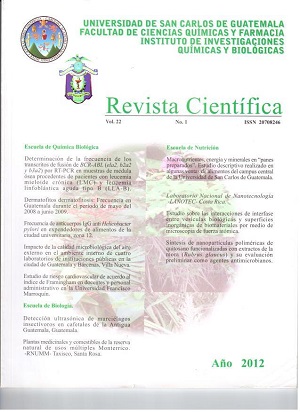Synthesis of polymer chitosan nanoparticles funtionalized with blackberry extracts (Rubus glaucus) and its preliminary evaluation as antimicrobial agents
Keywords:
antimicrobial agents, polyphenols, chitosan, polimeric nanoparticlesAbstract
Synthesis of polymer chitosan nanoparticles funtionalized with blackberryextracts(Rubus glaucus) and its preliminary evaluation as antimicrobial agents
Abstract
The aim of this study is to evaluate the bacteriostatic effect of functionalized chitosan nanoparticles withantioxidants from tropical fruit extracts.In the synthesis and characterization of functionalized chitosan nanoparticles variables are treated in orderto obtain concentrations and other parameters, which shows bacteriostatic effect on some species of pathogenicgram-negative ATCC bacterias: Escherichia coli, Serratia marcescens and Pseudomona aeroginosa, and grampositives:Staphylococcus aureus, Bacillus subtilis and Enterococcus faecalis.The hypothesis assumes that functionalized nanoparticles synthesized according to the ion gelation methodusing tripolyphosphate as crosslinking agent, with modifying agents from blackberry tropical fruit extracts(Rubus glaucus), containing antioxidants, expressed as gallic acid concentration, provides chitosan nanoparticlesthe ability to inhibit bacterial growth.This research performed a preliminary evaluation of the polyphenol content and antimicrobial activity inconjunction with the nanoparticles against pathogens mentioned above. The evaluated fruits exhibit concentrationsof 100 mg of gallic acid/100g and antimicrobial activity against the gram-positive S. aureus E. faecalis andB. subtilis, and the gram-negative S. marcescens determined by disc diffusion method showing an inhibitiondiameter between 10% and 60 % compared to positive control. These results show the potential of thesenanoproducts as antimicrobial agents for use in the pharmaceutical industry.
Key words:
antimicrobial agents, polyphenols, bacteriostatic effect, chitosan, polimeric
References
Referencias
Armentia, A., Lombardero, M., Barber, D., Callejo,
A., Vega, J., Martínez, C., y Rebollo, S. (1999).
Anafilaxia por moras (Morus nigra). Alergologia e
Inmunologia Clinica 14, 398-401.
Begin, A., y Calsteren, M. R. (1999). Antimicrobial
films produced from chitosan. International Journal
of Biological Macromol, 26, 63-67.
Fuentes, L. B., y Pastor de Abram, A. (2004).
Preparación, caracterización y evaluación de películas
de quitosano proveniente de calamar gigante
“Dosidicus gigas†para uso médico. Revista de la
Sociedad Química del Perú. Per, 75 (1).
Gutierréz, B. A. (2002). Chocolate, polifenoles y
protección a la salud. Acta Farmacèutica.
Bonaerense, 21 (2), 149-52.
Márquez, C., Cartagena, J., y Pérez, M. (2009).
Efecto de recubrimientos comestibles sobre la calidad
en poscosecha del níspero japonés (Eriobotrya
japonica T.). Revista de la Facultad de Química
Farmaceútica, 16, 304-310.
Peniche, C., Argüelles, W., Peniche, H., & Acosta,
N. (2003). Chitosan: An Attractive Biocompatible
Polymer for Microencapsulation. Macromolecular
Bioscience, 3, (10), 511–520.
Hassan, E., Parish, R., & Gallo, R. (1992). Optimized
formulation of magnetic chitosan microspheres
Mitra Pertanian Kita. https://www.mitratani.my.id/. Accessed 5 Dec. 2021.
Pharmaceutical Research, 9, 390-397.
Rinaudo, M. (2008). Main properties and current
applications of some polysaccharides as biomaterials.
Polymer. International. 57, (3), 97-430.
Madrigal, S., Rodríguez, G., Krueger, C., & Reed,
J. (2010). Evaluation of Costa Rican Traditional
Fruits as potencial sources of natural polyphenolic
antioxidants and antimicrobials. Inventi Journals, 1.
Ohya, Y., Takei, T., Kobayashi, H., & Ouchi, T.,
(1993). Release behavior of 5-fluorouracil from
chitosan-gel microspheres immobilizing 5-
fluorouracil derivative coated with polysaccharides
and their cell specific recognition. Journal of
Microencapsulation 10, 1-9.

